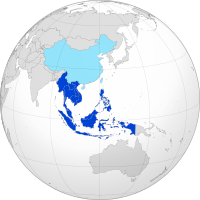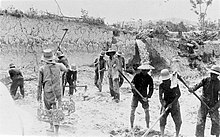Bamboo network
You can help expand this article with text translated from the corresponding article in Chinese. (October 2021) Click [show] for important translation instructions.
|
| 竹网 | |
|---|---|
 | |
| Countries and territories | |
| Languages and language families | Chinese, English, Burmese, Filipino, Indonesian, Khmer, Laotian, Malay, Thai, Vietnamese and many others |
| Major cities | |
The Bamboo network (simplified Chinese: 竹网; traditional Chinese: 竹網; pinyin: zhú wǎng) or the Chinese Commonwealth (simplified Chinese: 中文联邦; traditional Chinese: 中文聯邦; pinyin: Zhōngwén liánbāng) is used to conceptualize the links between businesses run by Overseas Chinese in Southeast Asia (in a narrower sense with the Hokkien and Teochew peoples).[1][2] It links the Overseas Chinese business community of Southeast Asia, namely Malaysia, Indonesia, Singapore, Thailand, Vietnam, the Philippines, and Myanmar with the economies of Greater China (mainland China, Hong Kong, Macau, and Taiwan).[3] Overseas Chinese companies in Southeast Asia are usually managed as family businesses in a centralized bureaucratic manner. In an article in The New York Review of Books, Indian critic Pankaj Mishra called it a "largest economic force in Asia outside of Japan".
Structure
[edit]Overseas Chinese businesses in Southeast Asia are usually family owned and managed through a centralized bureaucracy.[3][4][5] The businesses are usually managed as family businesses to lower front office transaction costs as they are passed down from one generation to the next.[5][6][3][4][7][8] These bulk of these firms typically operate as small and medium-sized businesses.[5][9][10]
Bamboo networks are also transnational, which means channeling the movement of capital, information, and goods and services can promote the relative flexibility and efficiency between the formal agreements and transactions made by family-run firms.[11] Business relationships are based on the Confucian paradigm of guanxi, the Chinese term for the cultivation of personal relationships as an ingredient for business success.[12][13][14]

Some Overseas Chinese businessmen include Malaysian dealmaker Robert Kuok, Indonesian banker and retail proprietor Liem Sioe Liong, and his son, financier and money manager Liem Hong Sien in addition to fellow Fuqing native and Salim Group co-founder and investor Liem Oen Kian, Filipino billionaire Henry Sy, and Hong Kong business tycoon Li Ka-shing.[6][15]
Much of the business activity of the bamboo network is centered in the major cities of the region, such as Mandalay, Jakarta, Singapore, Bangkok, Kuala Lumpur, Ho Chi Minh City, Phnom Penh, Vientiane, and Manila.[16]
History
[edit]Commercial influence of Chinese traders and merchants in Southeast Asia dates back at least to the third century AD, when official missions by the Han government were dispatched to countries in the Southern Seas. Distinct and stable Overseas Chinese communities became a feature of Southeast Asia by the mid-seventeenth century across major port cities of Indonesia, Thailand, and Vietnam.[17] More than 1500 years ago, Chinese merchants began to sail southwards towards Southeast Asia in search of trading opportunities and wealth. These areas were known as Nanyang or the Southern Seas. Many of those who left China were Southern Han Chinese comprising the Hokkien, Teochew, Cantonese, Hakka and Hainanese who trace their ancestry from the southern Chinese coastal provinces, principally known as Guangdong, Fujian and Hainan.[18] Periods of heavy emigration would send waves of Chinese into Southeast Asia. Unrest and periodic upheaval throughout succeeding Chinese dynasties encouraged further emigration throughout the centuries.[19] By the 12th century, Chinese began permanently settling in Thailand, and by the 13th century, in Cambodia.[20][21] In the early 1400s, the Ming dynasty Chinese admiral Zheng He under the Yongle Emperor led a fleet of three hundred vessels around Southeast Asia during the Ming treasure voyages.[22]
Since 1500, Southeast Asia has been a magnet for Chinese emigrants where they have strategically developed a bamboo network encompassing an elaborately diverse spectrum of economic activities spread across numerous industries.[23] The Chinese were one commercial minority among many including Indian Gujaratis, Chettiars, Portuguese and Japanese until the middle of the seventeenth century. Subsequently, damage to the rival trade networks the English and Dutch in the Indian Ocean allowed the enterprising Chinese to take over the roles once held by the Japanese in the 1630s.[24] Overseas Chinese populations in Southeast Asia saw a rapid increase following the Communist victory in the Chinese Civil War in 1949 which forced many refugees to emigrate outside of China causing a rapid expansion of the Overseas Chinese bamboo network.[16][25][26]
1997 Asian financial crisis
[edit]Governments affected by the 1997 Asian financial crisis introduced laws regulating insider trading led to the loss of many monopolistic positions long held by the ethnic Chinese business elite and weakening the influence of the bamboo network.[27] After the crisis, business relationships were more frequently based on contracts, rather than the trust and family ties of the traditional bamboo network.[28]
21st century
[edit]Following the Chinese economic reforms initiated by Deng Xiaoping started in 1978, businesses owned by the Chinese diaspora began to develop ties with companies based in mainland China. With China's entry into the global marketplace and its concurrent global economic expansion since the dawn of the 21st century, the Overseas Chinese community in Southeast Asia have served as a conduit for China's businesses.[29][30]
References
[edit]- ^ Pablos, Patricia (2008). The China Information Technology Handbook. Springer. p. 204.
- ^ Cheung, Gordon C. K.; Gomez, Edmund Terence (Spring 2012). "Hong Kong's Diaspora, Networks, and Family Business in the United Kingdom: A History of the Chinese "Food Chain" and the Case of W. Wing Yip Group". China Review. 12 (1). Chinese University Press: 48. ISSN 1680-2012. JSTOR 23462317.
Chinese firms in Asian economies outside mainland China have been so prominent that Kao coined the concept of "Chinese Commonwealth" to describe the business networks of this diaspora.
- ^ a b c Weidenbaum, Murray L.; Hughes, Samuel (1 January 1996). The Bamboo Network: How Expatriate Chinese Entrepreneurs are Creating a New Economic Superpower in Asia. Martin Kessler Books, Free Press. pp. 4–5. ISBN 978-0-684-82289-1.
- ^ a b Pablos (2008), p. 205.
- ^ a b c Yen (2008), p. 325.
- ^ a b c Richter (2002), p. 84.
- ^ Weidenbaum, Hughes (1996), p. 4.
- ^ Richter (2002), p. 180.
- ^ Richter (2002), p. 12–13.
- ^ Murray Weidenbaum (1 September 2005). One-Armed Economist: On the Intersection of Business And Government. Transaction Publishers. pp. 264–265. ISBN 978-1-4128-3020-1. Archived from the original on 21 May 2016. Retrieved 30 May 2013.
- ^ Weidenbaum, Murray (2012). The Dynamic American Firm. Springer (published February 10, 2012). p. 80. ISBN 978-1461313144.
- ^ Paz Estrella Tolentino (2007). H. W-C Yeung (ed.). Handbook of Research on Asian Business. Edward Elgar Publishing. p. 412. ISBN 978-1-84720-318-2. Archived from the original on 2016-05-21. Retrieved 2015-12-15.
- ^ "Templates of "Chineseness" and Trajectories of Cambodian Chinese Entrepreneurship in Phnom Penh*". Vrije Universiteit Amsterdam. p. 68. Archived from the original on 2017-08-16. Retrieved 2017-08-16.
- ^ Pablos (2008), p. 201
- ^ Richter, Frank-Jurgen (2002). Redesigning Asian Business: In the Aftermath of Crisis. Quorum Books. p. 83. ISBN 978-1567205251.
- ^ a b Weidenbaum, Hughes (1996), p. 8.
- ^ Yeung, H.; Olds, K. (1999). The Globalisation of Chinese Business Firms. Palgrave Macmillan. p. 5. ISBN 978-0333716298.
- ^ Mabbett, Hugh; Somers Heidhues, Mary F. (1992). The Chinese of South East Asia. Minority Rights Group (published December 3, 1992). p. 1. ISBN 978-0946690992.
- ^ Rae, I.; Witzel, M. (2016). The Overseas Chinese of South East Asia: History, Culture, Business. Palgrave Macmillan (published January 29, 2016). p. 3. ISBN 978-1349543045.
- ^ Zhou Daguan (2007). A Record of Cambodia. Translated by Peter Harris. University of Washington Press. ISBN 978-9749511244. Retrieved March 10, 2018.
- ^ Willmott (1967), p. 4
- ^ Chua, (2003), p. 31.
- ^ Weidenbaum, Hughes (1996), p. 24.
- ^ Reid, Anthony; Chirot, Daniel (1997). Essential Outsiders: Chinese and Jews in the Modern Transformation of Southeast Asia and Central Europe. University of Washington Press. p. 41. ISBN 978-0295976136.
- ^ Joint Economic Committee Congress of the United States (1997). China's Economic Future: Challenges to U.S. Policy (Studies on Contemporary China). Routledge. p. 428. ISBN 978-0765601278.
- ^ Chen, Min (2004). Asian Management Systems: Chinese, Japanese and Korean Styles of Business. International Thomson Business. p. 59. ISBN 978-1861529411.
- ^ Yeung, Henry. "Change and Continuity in SE Asian Ethnic Chinese Business" (PDF). Department of Geography, National University of Singapore. Archived from the original (PDF) on 2013-07-31. Retrieved 2017-08-16.
- ^ Min Chen (2004). Asian Management Systems: Chinese, Japanese and Korean Styles of Business. Cengage Learning EMEA. p. 205. ISBN 978-1-86152-941-1.
- ^ Quinlan, Joe (November 13, 2007). "Insight: China's capital targets Asia's bamboo network". Financial Times.
- ^ Weidenbaum, Hughes (1996), p. 27.
Further reading
[edit]- Chua, Amy (2003). World On Fire. Knopf Doubleday Publishing. ISBN 978-0385721868.
- Folk, Brian C.; Jomo, K. S. (2003). Ethnic Business: Chinese Capitalism in Southeast Asia (1st ed.). Routledge (published September 1, 2003). ISBN 978-0415310116.
- Gambe, Annabelle (2000). Overseas Chinese Entrepreneurship and Capitalist Development in Southeast Asia. Palgrave Macmillan. ISBN 978-0312234966.
- Gomez, Terence (2003). Chinese Business in Southeast Asia. Routledge. ISBN 978-0415326223.
- Gomez, Terence (2001). Chinese Business in Southeast Asia: Contesting Cultural Explanations, Researching Entrepreneurship. Routledge. ISBN 978-0700714155.
- Haley, George (1998). New Asian Emperors. Routledge. ISBN 978-0750641302.
- Hemrit, Maetinee (2010). Beyond the Bamboo Network: The Internationalization Process of Thai Family Business Groups. Stockholm School of Economics. ISBN 978-9172588431.
- Landa, Janet Tai (2016). Economic Success of Chinese Merchants in Southeast Asia. Springer. ISBN 978-3642540189.
- Paul Dana, Leo (1999). Entrepreneurship in Pacific Asia: Past, Present & Future. World Scientific Publishing. ISBN 978-9810239299.
- Rae, Ian (2008). The Overseas Chinese of Southeast Asia: History, Culture, Business. Palgrave Macmillan. ISBN 978-1403991652.
- Richter, Frank (1999). Business Networks in Asia: Promises, Doubts, and Perspectives. Praeger. ISBN 978-1567203028.
- Santasombat, Yos (2017). Chinese Capitalism in Southeast Asia: Cultures and Practices. Palgrave Macmillan. ISBN 978-9811046957.
- Suryadinata, Leo (1997). Ethnic Chinese as Southeast Asians. Singapore: Institute of Southeast Asian Studies. ISBN 981-3055-58-8.
- Suryadinata, Leo (2012). Southeast Asian Personalities of Chinese Descent: A Biographical Dictionary. Institute of Southeast Asian Studies. ISBN 9789814345217.
- Tagliacozzo, Eric; Chang, Wen-Chin (2011). Chinese Circulations: Capital, Commodities, and Networks in Southeast Asia. Duke University Press. ISBN 978-0-8223-9357-3.
- Tong, Chee-Kiong (2014). Chinese Business: Rethinking Guanxi and Trust in Chinese Business Networks. Springer. ISBN 978-9814451840.
- Wang, Gungwu (2002). The Chinese Overseas: From Earthbound China to the Quest for Autonomy. Harvard University Press. ISBN 978-0674009868.
- Willmott, William E. (1967). The Chinese in Cambodia. Publications Centre: University of British Columbia Press. ISBN 978-0774844413.
- Weidenbaum, Murray L.; Hughes, Samuel (1996). The Bamboo Network: How Expatriate Chinese Entrepreneurs Are Creating a New Economic Superpower in Asia. Free Press. ISBN 978-0684822891.
External links
[edit]- The Bamboo Network: Asia's Family-run Conglomerates – Strategy + Business January 1, 1998]
